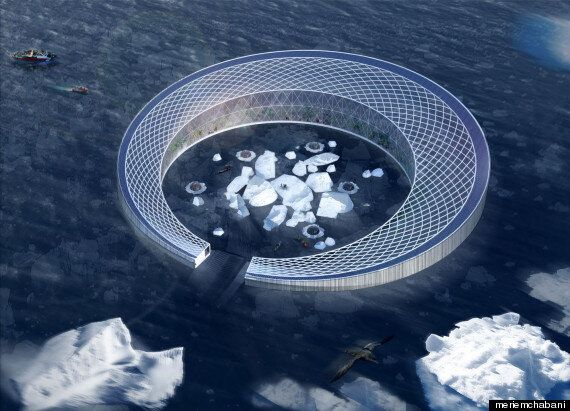Update: One of the students involved in the project has contacted us to clarify and correct some aspects of the project.
Meriem Chabani clarified that the hydroponic farms are powered by fresh water only in as in any other hydroponic system -- ie that the water, which is naturally rich in nutrients, can be used as a substitute for fresh water and soil.
"The point of using water from icebergs is that they already contain all the nutrients needed." she said.
She sadded:
"The osmotic energy generation system is not a battery. It works through the exchange between a saline and non-saline solution that can be used to drive a turbine mechanically, thereby generating electricity. This is a technology currently being developed by Norwegian company Statkraft."
She added:
Finally, we would like to state that we are currently working at Polarisk Analytics, an international political risk research consultancy dedicated to analysis of geo-political issues and geo-economic prospects in the polar regions, to develop prototypes.
Watching all those irreversibly melting icebergs slide into the ocean is pretty depressing in its own right.
But it also raises the prospect that our current urban homes are going to end up submersed in water - which, as thoughts go, is hardly a pick-me-up.
So in an effort to use the former to combat the latter, three French and one British students have designed a futuristic town which they say can be 'powered' (see above) by melting icebergs.
The 'Arctic Harvester' is a ring-shaped floating metropolis straight out of Waterworld.

The idea is the work of Meriem Chabani, Etienne Chobaux, John Edom, and Maeva Leneveu, and is highlighted in an extensive feature by FastCoExist.
Designed to host 800 colonists, the city (or rather village) also functions as a hydroponic farm.
The idea is to gather melting icewater - which is fresh - into a central 'bay', where it can be used. The city would gather solar power during the summer months, and provide the rest of its power through an osmotic system which uses a mix of salt and freshwater to generate electricity.
"The vessel as a whole is designed to drift with the currents that carry the icebergs during the course of their lives, often circling on the ocean currents between Greenland and the coast of Labrador for up to two years, before heading south past the east coast of the United States," Chabani told FastCo.

The project was instigated as a response to Greenland’s agricultural dependence, requiring the importation of almost all of required fresh fruit and vegetables from its less climatically and soil-fertility challenged neighbours. The solution proposed seeks not only to provide for that need, but also a reproducible model that, in the future, could swing Greenland’s balance of trade in this sector from deficit to surplus. In search of a fertile landscape for a barren territory, the Arctic Harvester deploys various technical, energy and sociological strategies.
Arranged in a circular form, it delivers icebergs into its central bay, from which the harvested fresh water is directed to the hydroponic farming levels, and later to the osmotic energy plant in a process that values and retains fresh water as a re-usable resource. The central bay is thus the heart of the Harvester’s agricultural process, the centre of its sustainable energy production, as well as an ice garden, offering social spaces and floating communal greenhouses for use by the inhabitants.